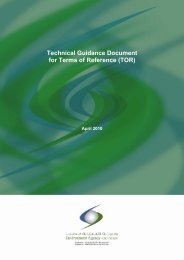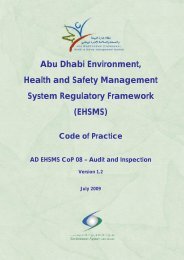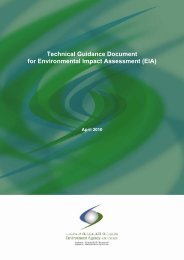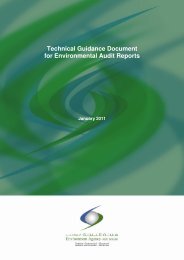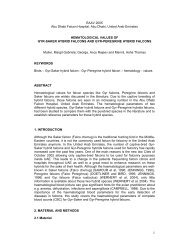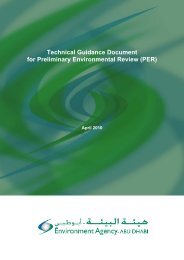Management options for the improvement of flamingo breeding at Al ...
Management options for the improvement of flamingo breeding at Al ...
Management options for the improvement of flamingo breeding at Al ...
Create successful ePaper yourself
Turn your PDF publications into a flip-book with our unique Google optimized e-Paper software.
(Johnson 1983, Rendon Martos and Johnson 1996, Baldassarre and Arengo 2000,Nasirwa 2000). Among <strong>the</strong>se, only dogs, red foxes and c<strong>at</strong>s are present in <strong>Al</strong>W<strong>at</strong>hba. Dogs are <strong>the</strong> most serious thre<strong>at</strong> <strong>for</strong> adult <strong>flamingo</strong>s, eggs and chicksduring <strong>the</strong> first weeks <strong>of</strong> nesting; once <strong>the</strong> chicks are mobile and <strong>for</strong>m <strong>the</strong> crèche(age: ca 10 days), <strong>the</strong> pred<strong>at</strong>ion impact is low. Previous <strong>breeding</strong> <strong>at</strong>tempts by<strong>flamingo</strong>s may have failed in part because <strong>of</strong> changing w<strong>at</strong>er levels th<strong>at</strong> ei<strong>the</strong>rflooded <strong>the</strong> nesting site, or when reduced made a link with <strong>the</strong> main land andthus, accessible to terrestrial pred<strong>at</strong>ors (Javed and Khan 2003). In 2002,<strong>flamingo</strong>s bred in “a peninsula” in <strong>the</strong> west part <strong>of</strong> <strong>the</strong> lake. This peninsula could beisol<strong>at</strong>ed from <strong>the</strong> main land by a trench (Figure 4). The method <strong>of</strong> trans<strong>for</strong>mingabandoned dikes into <strong>breeding</strong> island has been proven to be efficient to improve <strong>the</strong>establishment and <strong>the</strong> <strong>breeding</strong> success <strong>of</strong> w<strong>at</strong>erbird colonies th<strong>at</strong> were subject topred<strong>at</strong>ion by foxes and dogs in Mediterranean industrial salt pans (Sadoul et al.1998).Proposed actions:1. Control <strong>of</strong> w<strong>at</strong>er levels during <strong>the</strong> critical phase <strong>of</strong> <strong>the</strong> <strong>breeding</strong> season (nestbuilding to chick crèche <strong>for</strong>m<strong>at</strong>ion)2. Identific<strong>at</strong>ion <strong>of</strong> thre<strong>at</strong>s and control, if necessary, <strong>of</strong> potential terrestrialpred<strong>at</strong>orsa) Record <strong>of</strong> signs th<strong>at</strong> could help to identify <strong>the</strong> pred<strong>at</strong>or (tracks, faeces, etc…)in <strong>the</strong> vicinity <strong>of</strong> <strong>the</strong> <strong>breeding</strong> island and in case <strong>of</strong> pred<strong>at</strong>ion: shape <strong>of</strong> broken shells,hairs. Some camera-traps could be installed to gain fur<strong>the</strong>r insights on <strong>the</strong> pred<strong>at</strong>oridentity revealed by o<strong>the</strong>r marks.6





